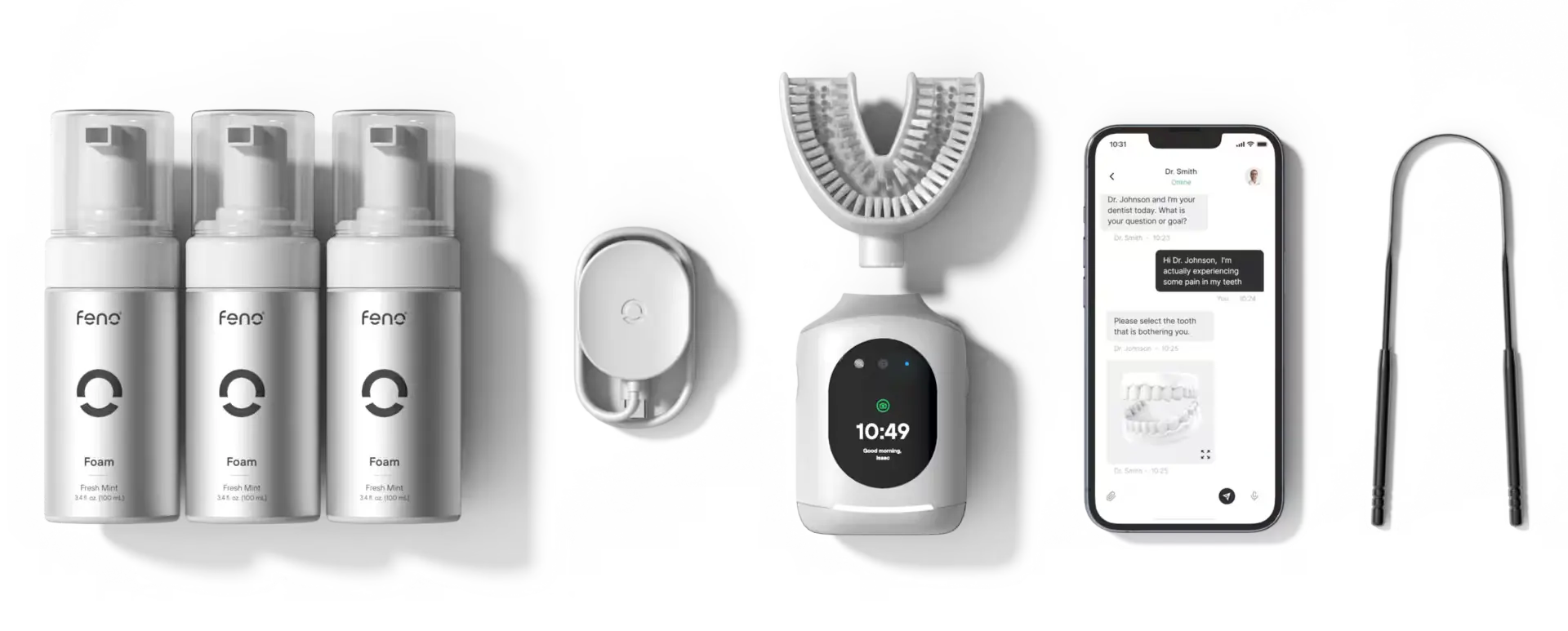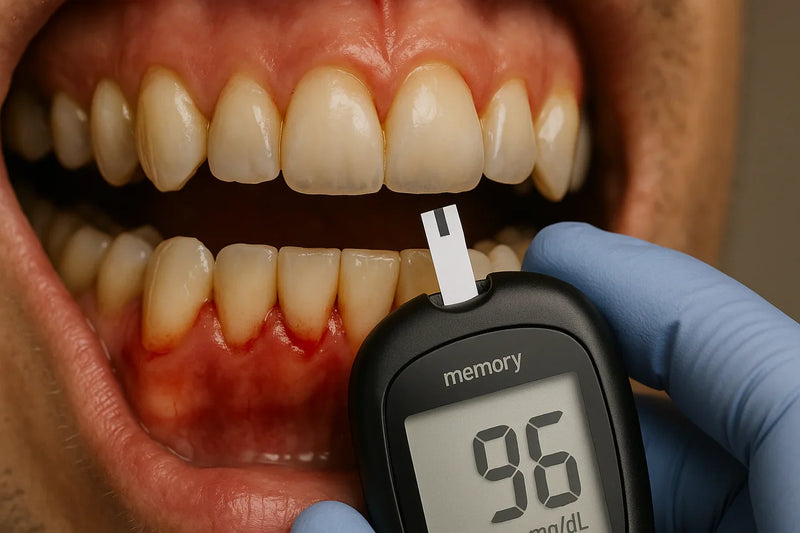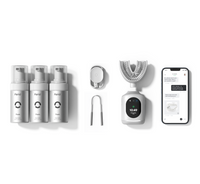
12 min read
What Makes A Toothbrush Truly Hygienic? Everything You Need To Know
Each time you brush, your toothbrush comes into contact with millions of bacteria from your mouth, as well as particles from the surrounding air. If left unchecked, this buildup can lead to health issues like gum infections and bad breath. To prevent this, using a hygienic toothbrush is crucial. It supports a healthier mouth and helps make brushing more effective. Many people focus on brushing techniques but forget that a dirty brush can undo all their efforts. Maintaining a clean brush ensures that you're not reintroducing harmful germs into your mouth. When paired with good habits.
Daily Cleaning Habits for a Hygienic Toothbrush
How to Clean Toothbrushes
One of the simplest but most important habits you can adopt is knowing how to clean your toothbrushes immediately after use. Rinse the bristles thoroughly under warm running water, making sure to remove all visible debris and leftover toothpaste. Move your fingers through the bristles to help release anything trapped inside. After rinsing, give it a light shake to remove excess water. This step is often skipped, but leaving water behind can make your brush a breeding ground for bacteria. Make sure no foam or residue is left clinging to the bristles. Avoid using soap or dishwashing liquids, as they can irritate your mouth if not completely rinsed out. Clean brushes help your oral care products work more effectively, giving your teeth and gums the best possible environment.

Thumb-and-Finger Rinsing
After brushing, take a moment to run your thumb and forefinger through the bristles under warm water. This method helps loosen buildup that rinsing alone might miss. It also gives you the chance to feel for any stiff or frayed bristles, which may indicate the need for replacement. Make sure your hands are clean before doing this step to avoid transferring bacteria. A cleaner brush supports a good oral hygiene routine by keeping tools fresh and ready for daily use. If you skip this extra step, you may end up with a toothbrush that carries particles from previous uses back into your mouth.
Proper Air-Drying Techniques
Bacteria thrive in moist environments, so a wet toothbrush can quickly become unhygienic if not aired out. The best approach is to place it upright in an open holder, allowing air to circulate freely around the bristles. Avoid laying the brush flat, as this keeps moisture trapped beneath it. Also, make sure it’s not touching others to prevent cross-contamination. A brush that dries fully between uses is far less likely to harbor harmful bacteria. Drying is just as important as rinsing when it comes to maintaining daily toothbrush hygiene.
Weekly and Deep Cleaning Solutions
Soaking Bristles
A simple method is to submerge the bristles in an antibacterial mouthwash or a diluted hydrogen peroxide solution for about 15 minutes. This helps kill germs that regular rinsing might miss. Use a clean cup and avoid reusing the liquid to prevent cross-contamination. Do not soak the entire handle, especially if it has battery parts. Rinse the brush thoroughly afterward to remove any chemical residue before using it again. This step supports a cleaner brushing experience throughout the week. This reduces buildup that can make your brush feel sticky or grimy over time. Incorporating this practice is a smart way to reinforce your efforts in maintaining a truly hygienic toothbrush without complicating your routine.
Toothbrush Cleaning Kits
Kits that use sonic agitation offer a powerful deep-cleaning option. These typically use a gentle vibration combined with cleansing solutions to loosen debris trapped between the bristles. This process mimics the action of ultrasonic jewelry cleaners but is designed for oral care tools. Many kits are compact and easy to use at home without professional help. They’re especially useful for electric toothbrush heads, which can be harder to clean by hand. Regular use of these kits can extend the life of your brush and make each brushing session more effective.
Using a Toothbrush With UV Sanitizer
This is one of the most advanced ways to keep your ultraviolet toothbrush clean. These devices expose their head to ultraviolet light, which destroys microorganisms by damaging their DNA. Most UV sanitizers are built into holders or cases, activating automatically after brushing. Adding UV sanitation to your routine not only boosts hygiene but also gives you confidence that your brush is safe to use every time. Investing in this technology may seem minor, but it can significantly reduce the risks of contamination. When considering a sterilizer for a toothbrush, it’s essential to assess both its safety and how well it performs. Look for sterilizers with clear usage instructions and safety certifications to avoid damaging your brush or causing injury. A high-quality sterilizer should be compatible with your brush type. Also, evaluate how long the sterilization cycle takes and how often it should be used. Reading customer reviews or consulting with your dentist can help you choose the right option.
Smart Storage Strategies That Prevent Contamination
Avoid Wet Caps and Enclosed Containers
The best way to store toothbrushes is to avoid caps or enclosed containers. This might appear hygienic at first glance, but doing so can actually lead to several health and maintenance issues. These coverings often create an environment that is far more harmful in the long run. Below are reasons why this should be avoided:
- Traps Moisture: After brushing, toothbrush bristles remain damp, and when you enclose them in a cap or airtight container, evaporation is severely restricted. The moisture that lingers becomes a breeding ground for harmful microbes. This humid microclimate sustains itself because the water vapor has nowhere to escape, often staying for hours or even an entire day. Without the ability to fully dry out, it doesn't return to a neutral, clean state. As a result, this persistent dampness not only promotes the survival of germs already present on the brush but also allows environmental bacteria to flourish. A damp brush in a sealed space is effectively a petri dish, encouraging an ongoing cycle of contamination each time you reuse it.
- Mold and Fungal Growth: Fungi thrive in moist, dark environments, and a capped toothbrush provides exactly that. Mold spores are everywhere in the air, and the moment they find a damp surface, especially one rich in organic debris, they begin to colonize. This growth can appear as black or green spots on the bristles or handle and may release musty odors as a sign of fungal activity. This risk is amplified when the toothbrush is stored in a closed cap without proper air circulation, making it a hidden but serious threat.
- Increases Bacterial Proliferation: The lack of airflow stifles the drying process and essentially traps bacteria in a warm, moist enclosure. These are ideal conditions for bacteria such as Streptococcus and Staphylococcus to reproduce rapidly. While some bacteria are already present in your mouth and on the brush, the goal of post-brushing hygiene should be to reduce these populations, not foster their growth. Instead, the cap turns it into a bacterial incubator. This can lead to gum infections if the bacteria enter the bloodstream through microabrasions in the gums.
- Reduces Toothbrush Lifespan: Bristles, which are designed to maintain a certain firmness for effective cleaning, become soft and warped when perpetually wet. This degrades their performance much faster than with open-air drying. The base of the bristles can loosen, making the brush ineffective at removing plaque. This leads to premature wear, forcing more frequent replacements.
Avoiding these mistakes will go a long way in supporting a truly antibacterial toothbrush experience that keeps your brushing routine safe and effective.

Positioning and Separation Tips
Never allow brushes to touch each other, as bacteria can transfer from one brush to another easily. Use holders that provide individual slots or barriers to keep brushes separated. If space is tight, wall-mounted racks or magnetic holders can help organize brushes while keeping them elevated and dry. Avoid storing them in drawers, as dark, closed spaces hinder drying. Families with young children should ensure that kids' brushes are positioned lower and away from adults' brushes to reduce contamination risk. This ensures your toothbrush for travel or at-home use stays safe and clean.
Hygiene Essentials for Travel and Portability
Portable Toothbrush
A portable toothbrush with built-in ventilation often comes with specially designed cases or foldable handles that allow airflow even when closed. This prevents moisture from getting trapped and discourages the growth of bacteria while your brush is stored in luggage or travel kits. Without proper ventilation, your brush could become damp and dirty, defeating the purpose of cleaning your teeth in the first place. A ventilated design supports drying and keeps the brush fresher until you need it again.
Keeping Your Toothbrush Clean in Transit
Avoid placing it directly on hotel sinks or nightstands where germs may linger. Instead, use a cup or a disinfected surface to support it upright. Carrying a small microfiber cloth can help you dry your brush before storing it again. Even though travel disrupts routines, these minor habits help protect your oral health and minimize the chance of contamination. Practicing this level of care supports your commitment to a toothbrush cleaning kit or any sanitation method that fits your lifestyle.
Tools, Features, and Routine Support for Daily Toothbrush Hygiene
Vibrating Toothbrushes
Choosing to buy vibrating toothbrushes that include pressure sensors can prevent long-term harm to your teeth and gums. These smart brushes vibrate at high speeds, helping to break up plaque without the need for excessive force. The pressure sensors serve as a guide, warning you when you’re pressing too hard and potentially causing gum recession or enamel wear. The result is a gentler, more effective clean that supports gum health. Many of these brushes also come with different modes for whitening or sensitivity, giving users advanced oral care. Adding this tool to your bathroom can improve technique and reduce the likelihood of overbrushing.
Use of Toothbrush and App Combos
Smart toothbrushes paired with companion mobile apps are transforming the way we approach daily oral hygiene tips. Through Bluetooth connectivity and intelligent algorithms, users gain real-time insights and long-term guidance. Here are its benefits:
- Replacement Alerts: Many people unknowingly use their toothbrushes far beyond the point of effectiveness. A toothbrush paired with an app can monitor usage frequency and duration, sending timely notifications when it's time to replace the brush head. This is especially valuable because wear isn’t always visible. These alerts help prevent oral issues that stem from ineffective brushing, such as gum disease and tartar buildup, making the replacement process both proactive and personalized.
- Brushing History Logs: Smart toothbrush apps automatically record when and how long you brush, forming a detailed log of your hygiene behavior. These logs help users identify skipped days or inconsistent routines, which might not be noticed otherwise. The historical data is typically displayed in intuitive visual formats, making it easy to understand and act on. This feature is especially useful for children or individuals trying to establish better oral care habits.
- Real-Time Feedback: Using built-in sensors, the toothbrush can detect brushing angles and coverage. This information is then transmitted in real time to the app, which offers audio or visual cues to guide improvements. For instance, if you're pressing too hard or missing certain areas, the app will alert you to adjust your technique. This live correction helps reinforce good habits and minimize potential damage. Unlike traditional brushing, where errors go unnoticed, this system acts like a digital coach, ensuring every session is as effective and gentle as possible. Users develop a muscle memory for the correct technique.
- Personalized Tips: After analyzing your data, the app can suggest specific improvements, such as spending more time on the molars or using a gentler touch in certain zones. The guidance evolves as your habits change, ensuring that the advice remains relevant and practical.
- Progress Reports: Weekly or monthly reports aggregate your brushing metrics into charts or scores, showing where you’ve improved and where attention is still needed. These summaries highlight performance and offer motivation through achievements. These reports can reinforce positive behavior by showing tangible results, such as reduced instances of missed brushing or improved pressure control.
Whether you're seeking better technique or simply want to stay on top of replacements, this technology makes achieving and maintaining good oral health easier and more intuitive than ever before.

Selecting Soft Heads
Soft-bristled heads are widely recommended by dental professionals because they clean effectively without damaging delicate gum tissue. Unlike firm bristles, soft ones bend to reach around the gumline and between teeth, removing plaque without causing irritation. In addition to being gentler, many soft brush heads are designed to resist microbial buildup. Some are infused with antibacterial coatings, which slow the growth of germs on the bristles between uses. If you're investing in your dental health, a toothbrush for oral hygiene with soft bristles should be at the top of your list.
Taking care of your teeth starts with the tools you rely on. Prioritize keeping your toothbrush clean and stored in a way that prevents contamination. These daily and weekly efforts create a cycle of prevention that protects both your toothbrush and your teeth. Embracing these habits leads to better results over time. With each small improvement, you're building a foundation for a healthier mouth and a good oral hygiene routine.
Share



